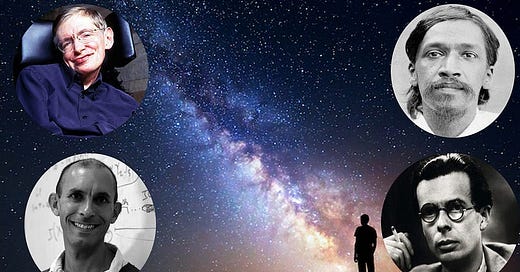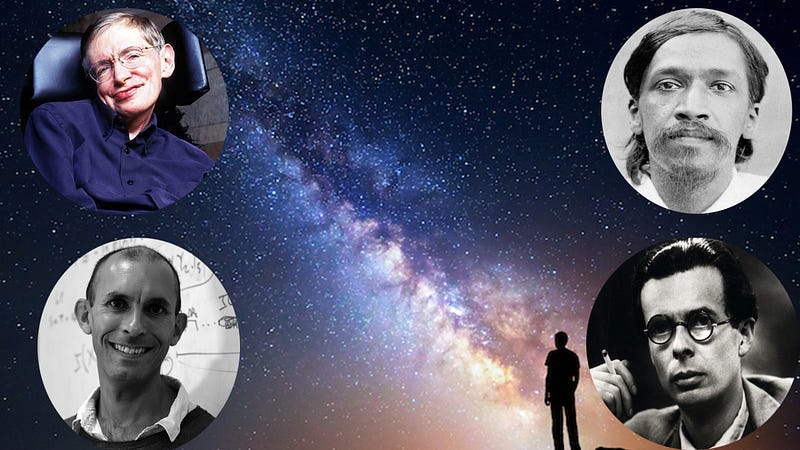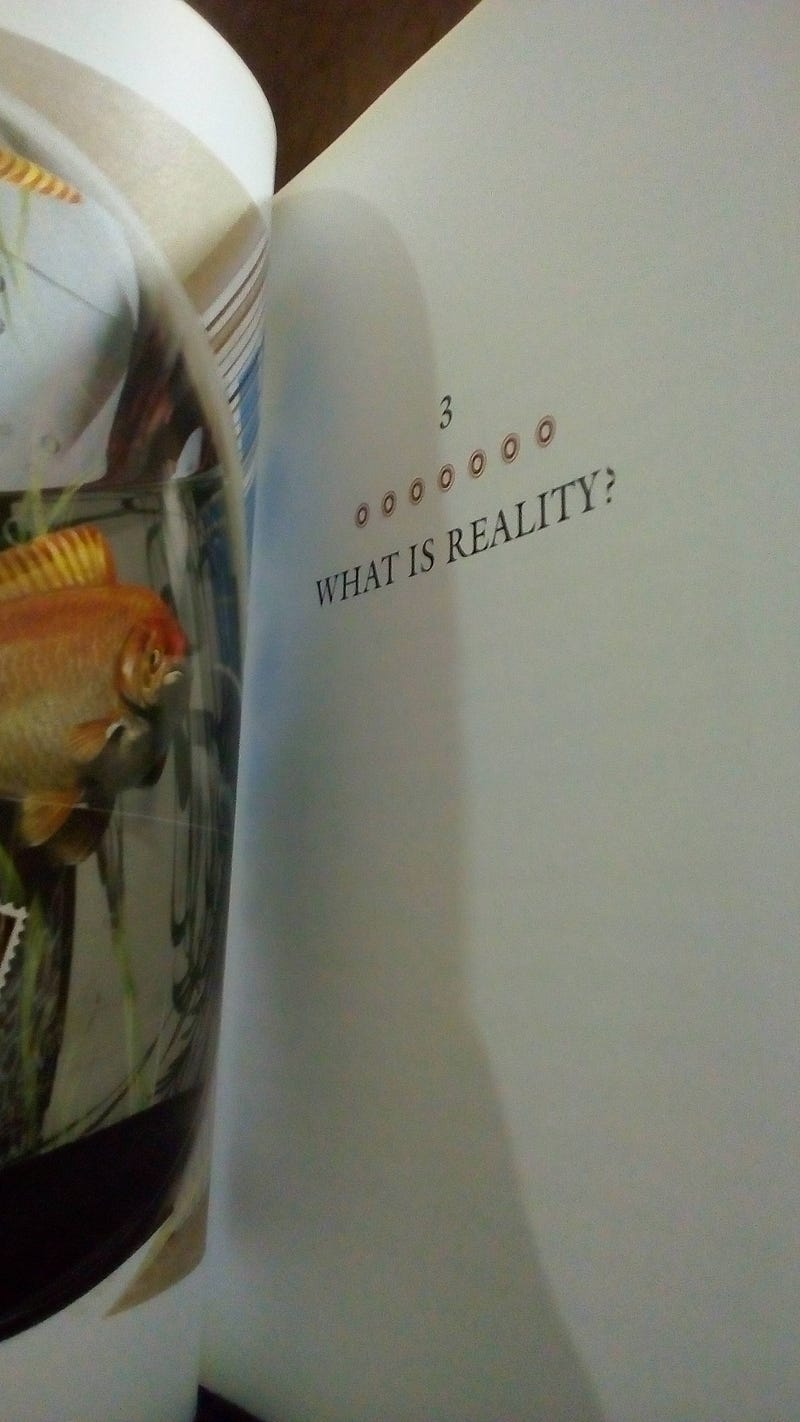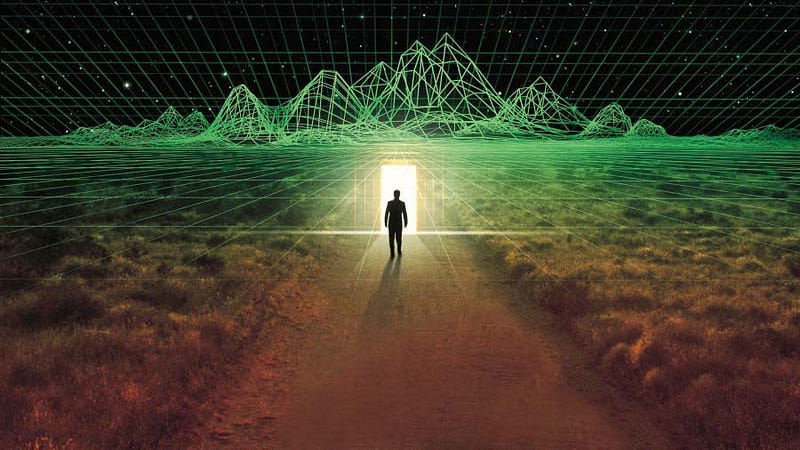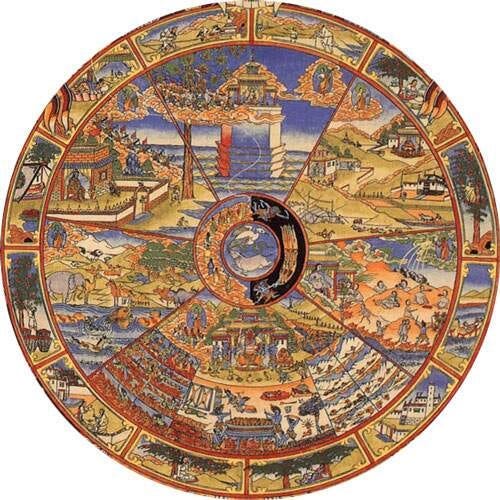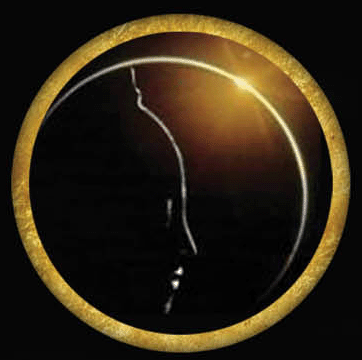Confluence In The Void Of Oneness
What is life about? Why are we here? What is reality? What is in our perception and how does it affect the world we perceive? A mix of Western & Easten thought pose the answer
Confluence In The Void Of Oneness: A Brief Delve Into The Teachings of Stephen Hawking, Aldous Huxley, Anil Seth & Sri Aurobindo
The following article is one of my older articles from 7 years ago when I just started blogging & it’s based on my reading of the work of Stephen Hawking, Aldous Huxley, & Sri Aurobindo & a groundbreaking video by Anil Seth. I’d encourage you to read it at length & watch Seth’s TED Talk linked herein.
It contains viewpoints from physics, to philosophy, technology, biology & spiritualityIt’s a bit of a long read but I’ve tried to find the converging congruence in their work like spheres of a Venn diagram. It’s pretty interesting if you go through the whole thing!
What is life about? Why are we here? What is reality? What is in our perception and how does it affect the world we perceive? What is the universe? What is our purpose? — These are not your regular questions to put forth to people in everyday situations in life and very few can answer them, yet I’ve found myself to be deeply contemplative of these basic questions of existence for as long as I can remember, to understand more about the reality we live in and our role in it. I’ve tried to explain that here.
Read on….
The world lost a brilliant mind and a true fighter in all senses of the word in Stephen Hawking this year, on the 14th of March and he left behind his life’s work in relics of information about our universe. That was his legacy — to simplify mankind’s questions about the cosmos.
I often feel that people glorify people in the wrong professions. Movie stars, sports, and music icons are fine, but to me, the real people who should be glorified are the innovators, thinkers, and inventors of the newest breakthroughs in the ever-progressing world, like scientists, physicists, academians, writers, poets and people who left behind treasure chests of knowledge for us to learn and quench our curiosity.
I believe the phrase I came across about reading and feeding your curiosity was, “standing on the shoulder of giants” by Sir Isaac Newton. Elon Musk, however, is perhaps one of the few who has managed to break the norm and is a rare celebrated innovator. But I digress.
It’s the 14th of May 2018, a warm enveloping summer night where the humidity and the heat from the hot afternoon are still contained in my room(The air conditioner isn’t functioning properly at the moment) but I still have the urge to write at 2:30 am.
This part of this article is about one chapter from the book “The Grand Design” by Stephen Hawking.
At the beginning of the chapter, Hawking provides an elegant analogy to base the rest of the chapter. He talks about a goldfish in a fishbowl and how it observes the world/universe around it, based on its frame of reference inside the fishbowl. He writes, “… A fish in a bowl with curved sides, gazing out, has a distorted view of reality. But how do we know we have the true, undistorted picture of reality? Might not we ourselves also be inside some big goldfish bowl and have our vision distorted? The goldfish’s picture of reality is different from ours, but can we be sure it is less real?”
He goes on to explain how the goldfish would formulate its scientific laws from its frame of reference inside the fishbowl. Like for example, a freely moving object that we would observe to be moving in a straight line would appear to the goldfish as moving along a curved path.
He writes further, “Nevertheless, the goldfish could still formulate scientific laws from their distorted frame of reference that would always hold true and that would enable them to make predictions about the future motion of objects outside the bowl. Their laws would be more complicated than the laws in our frame, but simplicity is a matter of taste. If a goldfish formulated such a theory, we would have to admit that the goldfish’s view as a valid picture of reality.”
He goes on to explain about theories from the formative years of Western thought. In Greek thinker Ptolemy’s model of the universe, around 150 AD, the earth was spherical, stationary, motionless, and positioned at the center of the universe.
He writes, “In Ptolemy’s model the earth stood still at the centre of the universe and the planets and stars moved around it in complicated orbits involving epicycles, like wheels on wheels. This model seemed natural because we don’t feel the earth moving under our feet… It was not until 1543 that an alternative model was put forward by Copernicus. Copernicus described a world where the sun was at rest and the planets revolved around it in circular orbits.”
Of course, these were early theories of the great thinkers from ancient times, but it has since been proved or rather observed that the Copernican theory is accurate, except that the planets orbit the sun in elliptical orbits. However, Hawking argues that Ptolemy’s theory cannot be dismissed.
He writes, “Although it is not uncommon for people to say that Copernicus proved Ptolemy wrong, that is not true. As in the case of our normal view versus that of the goldfish, one can use either picture as a model of the universe, for our observations of the heavens can be explained by assuming either the earth or the sun to be at rest. Despite its role in philosophical debates over the nature of our universe, the real advantage of the Copernican system is simply that the equations of motion are much simpler in the frame of reference in which the sun is at rest.”
Hawking goes on to write about the theory proposed in the hit movie ‘The Matrix’. We’ve all seen the movie and they propose that we are living in a computer simulation controlled by machines. This is somewhat related to Prof. Nick Bostrom’s actual theory suggesting that we are living in a computer simulation, which is called the simulation argument.
Bostrom’s paper states, “Many works of science fiction as well as some forecasts by serious technologists and futurologists predict that enormous amounts of computing power will be available in the future. Let us suppose for a moment that these predictions are correct. One thing that later generations might do with their super-powerful computers is run detailed simulations of their forebears or of people like their forebears. Because their computers would be so powerful, they could run a great many such simulations.”
“Suppose that these simulated people are conscious (as they would be if the simulations were sufficiently fine-grained and if a certain quite widely accepted position in the philosophy of mind is correct). Then it could be the case that the vast majority of minds like ours do not belong to the original race but rather to people simulated by the advanced descendants of an original race. It is then possible to argue that, if this were the case, we would be rational to think that we are likely among the simulated minds rather than among the original biological ones.”
There is more on it here if you’re interested: https://www.simulation-argument.com/
Coming back to The Grand Design, Hawking writes, “These examples bring us to a conclusion that will be important in this book: there is no picture- or theory-independent concept of reality.”
I’ll repeat that statement. There simply isn’t any concept of reality that isn’t a theory, picture, or a model. There is no absolute true fundamental explanation of reality.
He writes further, “Instead we will adopt a view that we will call model-dependent realism: the idea that a physical theory or world picture is a model (generally of a mathematical nature) and a set of rules that connect the elements of the model to observations. This provides a framework with which to interpret modern science.”
Hawking goes on to explain about philosophical realism and anti-realism.
Realism by definition is: “Realism (in philosophy) about a given object is the view that this object exists in reality independently of our conceptual scheme. In philosophical terms, these objects are ontologically independent of someone’s conceptual scheme, perceptions, linguistic practices, beliefs, etc.”
“Realism can be applied to many philosophically interesting objects and phenomena: other minds, the past or the future, universals, mathematical entities (such as natural numbers), moral categories, the physical world, and thought.”
Realism can also be a view about the nature of reality in general, where it claims that the world exists independent of the mind, as opposed to anti-realist views (like some forms of skepticism and solipsism, which deny the existence of a mind-independent world). Philosophers who profess realism often claim that truth consists in a correspondence between cognitive representations and reality.” (Source: Wiki)
Anti-realism by definition is: “In anti-realism, the truth of a statement rests on its demonstrability through internal logic mechanisms, such as Frege’s context principle and Heyting’s intuitionistic logic, in direct opposition to the realist notion that the truth of a statement rests on its correspondence to an external, independent reality. In anti-realism, this external reality is hypothetical and is not assumed.” (Source: Wiki)
Hawking writes about the philosophical debate between Realism and Anti-Realism, “Though realism may be a tempting viewpoint, as we’ll see later, what we know about modern physics makes it a difficult one to defend. For example, according to the principles of quantum physics, which is an accurate description of nature, a particle neither has a definite position nor a definite velocity unless and until those quantities are measured by an observer.”
I remember studying this in my first year of engineering in quantum physics about wave-particle duality and how the observer changes the outcome of a quantum experiment by observing the particles differently.
Here is a small video explaining wave-particle duality and the effect of an observer on the experiment:
Hawking writes, “It is therefore NOT correct to say that a measurement gives a certain result because the quantity being measured had that value at the time of the measurement. In fact, in some cases, individual objects don’t even have an independent existence but rather exist only as a part of an ensemble of many.”
So the realists’ view is false, which is proven by modern physics, despite it being the way most of us view reality as something that exists independent of anything else & being “real” & the ultimate truth. But this is wrong.
About anti-realists, Hawking writes, “Traditionally those who didn’t accept realism have been called anti-realists. Anti-realists suppose a distinction between empirical knowledge and theoretical knowledge.”
“They typically argue that observation and experiment are meaningful but that theories are no more than useful instruments that do not embody any deeper truths underlying the observed phenomena. Some anti-realists have even wanted to restrict science to things that can be observed. For that reason, many in the nineteenth century rejected the idea of atoms on the grounds that we would never see one.”
Which again is false, atoms exist and they are the building blocks of matter & everything we see. So the anti-realist viewpoint is false as well. So where do we turn?
Hawking writes, “Model-dependent realism short-circuits all this argument and discussion between the realist and anti-realist schools of thought. According to model-dependent realism, it is pointless to ask whether a model is real, only whether it agrees with observation. If there are two models that both agree with observation, like the goldfish’s picture and ours, then one cannot say that one is more real than another. One can use whichever model is more convenient in the situation under consideration.”
He goes on to explain how if we were inside the goldfish’s bowl we would have to turn to the goldfish’s theory. But we’re outside, so we have to turn to the theories inside our fishbowl i.e. the earth.
The next and very interesting part is about how our brain perceives reality. I’ll add parts by the infamous Aldous Huxley from his book The Doors Of Perception as well. But let’s just go along with Hawking for the moment because he’s got the drift….
Hawking writes, “We make models in science, but we also make them in everyday life. Model-dependent realism applies not only to scientific models but also to the conscious and subconscious mental models we all create in order to interpret and understand the everyday world. There is no way to remove the observer — us — from our perception of the world, which is created through our sensory processing and through the way we think and reason. Our perception — and hence the observations upon which our theories are based — is not direct, but rather shaped by a kind of lens, the interpretive structure of our human brains.”
“Model-dependent realism corresponds to the way we perceive objects. In vision, one’s brain receives a series of signals down the optic nerve. Those signals do not constitute the sort of image you would accept on your television. There is a blind spot where the optic nerve attaches to the retina, and the only part of your field of vision with good resolution is a narrow area of about 1 degree of visual angle around the retina’s center, an area the width of your thumb when held at an arm’s length. And so the raw data sent to the brain are like a badly pixilated picture with a hole in it.”
That’s all our brains can handle and process. Here’s where it gets interesting…
Hawking continues, “Fortunately, the human brain processes that data, combining the input from both eyes, filling in gaps on the assumption that visual properties of neighboring locations are similar and interpolating. Moreover, it reads a two-dimensional array of data from the retina and creates from it the interpretation of three-dimensional space. The brain, in other words, builds a mental picture or model.”
Taking a slight detour and a psychedelic twist, I will now quote the words of Aldous Huxley, from his book “The Doors Of Perception”
Huxley’s brilliant book, for those who don’t know, is about his ingestion of Mescaline — a powerful psychedelic drug and him describing his mescaline trip as part of an experiment. By definition: “Mescaline is a hallucinogen obtained from the small, spineless cactus Peyote (Lophophora williamsi). Mescaline is also found in certain members of the Fabaceae (bean family). From the earliest recorded time, peyote has been used by natives in northern Mexico and the southwestern United States as a part of traditional religious rites. Mescaline is used primarily as a recreational drug and is also used to supplement various types of meditation and psychedelic therapy.”
Coming back, to correlate what Hawking was talking about i.e. the human brain and its process of perceiving the world, Aldous Huxley writes, “Reflecting on my experience, I find myself agreeing with the eminent Cambridge philosopher, Dr. C.D.Broad, ‘that we should do well to consider much more seriously than we have hitherto been inclined to do the type of theory which Bergson put forward in connection with memory and sense perception. The suggestion is that the function of the brain and nervous system and sense organs is in the main eliminative and not productive.”
Huxley continues, “Each person is at each moment capable of remembering all that has ever happened to him and of perceiving everything that is happening everywhere in the universe (as per 100% brain utilization). The function of the brain and nervous system is to protect us from being overwhelmed and confused by this mass of largely useless and irrelevant knowledge, by shutting out most of what we should otherwise perceive or remember at any moment, and leaving only that very small and special selection which is likely to be practically useful.”
“According to such a theory, each one of us is potentially mind-at-large. But in so far as we are animals, our business is at all costs to survive. To make biological survival possible, mind-at-large has to be funneled through the reducing valve of the brain and nervous system. What comes out of the other end is a measly trickle of the kind of consciousness that will help us to stay alive on the surface of this particular planet.”
So in essence, our brain perceives only a measly trickle of reality.
Huxley continues, “That which in the language of religion is called ‘this world’ is the universe of reduced awareness, expressed and, as it were, petrified by language. The various ‘other worlds’, with which human beings erratically make contact are so many elements in the totality of the awareness belonging to Mind at Large. Most people, most of the time, know only what comes through the reducing valve and is consecrated as genuinely real by the local language.”
“Certain persons, however, seem to be born with a kind of bypass that circumvents the reducing valve. In others, temporary by-passes may be acquired either spontaneously, or as the result of deliberate ‘spiritual exercises’, or through hypnosis, or by means of drugs.”
“Through these permanent or temporary by-passes there flows, not indeed the perception ‘of everything that is happening everywhere in the universe’ (for the by-pass does not abolish the reducing valve, which still excludes the total content of mind-at-large), but something more than, and above all something different from, the carefully selected utilitarian material which our narrowed, individual minds regard as complete, or at least sufficient, picture of reality.”
Now, there is an interesting TED Talk I came across by neuroscientist Anil Seth that suggests that our entire reality is a controlled hallucination. He seems to concur with Hawking and Huxley & their biological explanations, saying that the brain gives us its best guess of what we perceive.
According to Seth, we’re all hallucinating all the time; when we agree about our hallucinations, we call it “reality.” He argues that the reality we see has as much to do with inside out i.e. from the brain to view as much as outside in, from view to brain.
Have a listen to this:
So to summarize Hawking, Huxley, and Anil Seth there is no fundamental and real, absolute reality. Our hypotheses for explaining it are simply our theories based on our frame of reference here on Earth which is similar to the goldfish in the fishbowl. Model-dependent realism suggests that either view is accurate based on convenience and observation. The particles within our universe change with our observation as proved by quantum physics. Our reality is a mere trickle of information being processed by the brain in an eliminative fashion i.e. it’s best guess of what’s out there. And according to Seth, what we see is also dependent on, inside out (from the brain to vision) rather than just outside in(from vision to brain).
That’s some glimpses of Western thought right from the 50s and Huxley to the millennium and Hawking and a few years ago with Seth. They’re all trying to explain reality.
But what about the self? Seth does touch upon it. What about our purpose and why we’re here? For that, we will have to look East and explore some older Indian knowledge.
Read on…
This time last year I was in Pondicherry, a small coastal town in Tamil Nadu, South India where I went to drop my sister off for her internship with Auroville Consulting. Auroville is a self-sufficient and self-sustained township just outside Pondicherry which is home to people from all over the world, some foreigners have even been born there and have Indian names and speak Tamil better than me. It was quite a fascinating place to behold when I went there. While I stayed inside Auroville for just a couple of days, there was something unerringly calm, pervading silent energy about the place, that echoed into its nearby surroundings as well. I stayed in a beach resort by the sea just outside the township and had one of the most peaceful vacations I have had in a long time.
While I was there, I picked up a book by Sri Aurobindo. Aurobindo was the founder of Auroville and he was a highly educated man who lived from his birth on 15th August 1872 to 5th December 1950. The book is called “The Integral Yoga” which has his perspective based on Indian teachings. It has very little to do with the “yoga” people are usually familiar with i.e. the exercises (asanas) and so on. It’s more to do with the awakening of the self.
In the chapter “Planes Of Consciousness and Parts of the Being”, Sri Aurobindo writes, “In my explanation of the universe, I have put forward this cardinal fact of a spiritual evolution as the meaning of our existence here. It is a series of ascents from the physical being and consciousness to the vital, (i.e) the being dominated by the life-self(soul), thence to the mental being realised in the fully developed man and thence into the perfect consciousness which is beyond the mental, into the supramental consciousness and the supramental being, (i.e) the truth-consciousness which is the integral consciousness of the spiritual being.”
“The mind cannot be our last conscious expression because the mind is fundamentally an ignorance seeking for knowledge; it is only the supramental truth-consciousness that can bring us the true and whole self-knowledge and world-knowledge; it is through only that, that we can get to our true being and the fulfillment of our spiritual evolution.”
But what is the Truth-Consciousness that brings self-knowledge and world-knowledge? Well, it’s the same state of being realized souls have reached, whether Buddha or any other such realized soul in history. India is home to a number of ancient spiritual texts that speak about self-actualization as the purpose of a soul here on Earth, right from the Vedas and Upanishads to the Bhagwad Gita and so on.
Aurobindo explains, “There is a truth-consciousness as it is called in the Veda, a Supermind, as I have termed it, possessing Knowledge, not having to seek after it and constantly miss it. In one of the Upanishads a being of knowledge is stated to be as the next step above the mental being; into that the soul has to rise and through it to attain the perfect bliss of spiritual existence.”
“If that could be achieved as the next evolutionary step of nature here, then he/she would be fulfilled and we could conceive of the perfection of life even here, its attainment of a full spiritual living even in this body or it may be in a perfected body.”
Aurobindo further compares Western and Indian thought saying, “The science of the West has discovered evolution as the secret of life and its process in this material world; but it has laid more stress on the growth of form and species than on the growth of consciousness: even, consciousness has been regarded as an incident and not the whole secret of the meaning of the evolution.”
“An evolution has been admitted by certain minds in the East, certain philosophers, and scriptures. There its sense has been the growth of the soul through developing or successive forms and many lives of the individual to its own highest reality.”
Aurobindo further writes that our cycle of evolution i.e the series of births and deaths of the soul in different forms, that it may not be necessarily upward and it can be upward and downward and upward again, a series of ascents and descents, until it has fulfilled all it’s wishes and is ready for the next step in its evolution.
He writes that the soul re-emerges in new forms suitable for new ages. That would explain why some people are already ready to give up the materialistic world and world of various pleasures for one of spiritual growth and meditation and so on. It’s simply a soul in a more advanced stage of the cycle of evolution.
And eloquently ending the chapter he writes, “The ascent of the human soul to the supreme spirit is that soul’s highest aim and necessity, for that is the supreme reality; but there can be too the descent of the spirit and its powers into the world and that would justify the pursuit of the material world also, give a meaning, a purpose to life & creation and solve its riddle. East and West could be reconciled in the pursuit of the highest and largest ideal, (i.e.) Spirit embrace Matter and Matter find its own true reality and the hidden reality in all things in the Spirit.”
Confluence In The Void Of Oneness — So there you have it, a few interesting explanations to life’s questions and certainly interesting perspectives & knowledge from some great thinkers of the 20th and 21st centuries. While Western and Indian thought are very different, there is an inherent confluence in the void, i.e. in satisfying the soul and quenching the mind’s curiosity. It’s further proof of the old saying that things are not quite as they seem.
I hope you found this post informative & it helped you in some way. As always, feel free to subscribe to my publication Light Years & support it & also share it if you’d like.
If you’d like to thank me for this post, if it helped you, or you found value in it, you can buy me a coffee instead of, or alongside subscribing to this publication by scanning the QR code below so that I can nice sip my next brew of coffee, all thanks to you! :)

